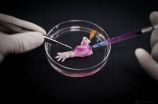(Press-News.org) PHILADELPHIA--(June 2, 2015)--Senescence, a phenomenon in which cells cease to divide and grow, can be caused by everything from natural DNA damage to treatment with chemotherapy. However, several mechanisms allow for cells to bypass senescence and grow out of control, eventually becoming cancerous. Now, scientists at The Wistar Institute have identified how a specific variant of a key protein complex found in human cells called condensin can reorganize a cell's genetic architecture in such a way as to promote senescence, making it an important facilitator in a cell's anticancer ability.
The findings were published online by the journal Cell Cycle.
This novel mechanism by which condensin is able to drive senescence could give researchers clues on important targets for future therapies designed to halt the progression of cancer.
Each of our cells contains enough DNA that, if stretched out in a line, would total about six feet in length. Condensin helps to compact all of that essential genetic information into something that can fit into a microscopic cell to enable the formation of chromosomes and preserve the DNA when a cell divides. Many eukaryotic cells - cells that have an organized nucleus - have two types of condensin, each of which has its own specific subunits that dictate its activity. In his lab, Ken-ichi Noma, Ph.D., associate professor in Wistar's Gene Expression and Regulation Program, has studied how condensin II complexes are able to modulate gene expression in a variety of organisms, including humans.
"Because of its role in the regulation of gene expression, we knew that condensin II likely played an important role in genome organization and architecture," said Noma, who is lead author of this study. "However, we did not fully understand the connection it might have with senescence. With these latest findings, we show that one specific subunit in condensin II leads to cellular senescence, thus revealing important information about the anti-cancer activity of our cells."
In this study, Noma and his colleagues looked at subunits of the condensin II complex. When comparing the condensin II complex of a normal cell line with those of three cancerous cell lines, they found that two different sizes of a particular subunit existed in the normal cell line: a full length version of the antibody hCAP-H2 and a shortened version called hCAP-H2ΔN. However, only the full length version existed in the cancer cell lines. When restimulation assays were performed, the researchers were able to confirm that the full length version of hCAP-H2 was highly involved in mitosis, an essential process that enables cells to keep growing, thus confirming the role they play in cancerous cells.
However, they discovered that both versions of hCAP-H2 play an important role in senescence, with the ΔN more likely participating in the induction of senescence. First, the researchers observed that the overexpression of both forms of hCAP-H2 induced senescence. The researchers then further observed that the expression of the ΔN variant increased during Ras-induced senescence. Ras is a cancer causing gene, or oncogene, which would normally be associated with abnormal cell growth and proliferation. However, depending on the cellular environment, activated Ras can act as a tumor suppressor by causing senescence.
"Condensin II complex is part of an interesting protein complex contributing to a cell nucleus environment that antagonizes proliferation," said Dario C. Altieri, M.D., president and CEO of the Wistar Institute and director of The Wistar Institute Cancer Center. "Through Noma's work, we now understand its molecular function in cellular senescence, and it may be possible that this pathway plays an important first line of defense against the emergence of tumors in humans, activating an irreversible senescence program in the malignant cell."
INFORMATION:
This work was supported by the W.W. Smith Charitable Trust, the V Foundation, the Edward Mallinckrodt Jr. Foundation, and Wistar Pilot Project funds to Ken-ichi Noma. Core facilities support was provided by the Cancer Center Support Grant (CCSG) CA010815.
Other co-authors of this study include Rugang Zhang, Yuhki Yokoyama, and Hengrui Zhu from The Wistar Institute.
The Wistar Institute is an international leader in biomedical research with special expertise in cancer research and vaccine development. Founded in 1892 as the first independent nonprofit biomedical research institute in the country, Wistar has long held the prestigious Cancer Center designation from the National Cancer Institute. The Institute works actively to ensure that research advances move from the laboratory to the clinic as quickly as possible. Wistar Science: today's discoveries - tomorrow's cures. http://www.wistar.org.
A team of Massachusetts General Hospital (MGH) investigators has made the first steps towards development of bioartificial replacement limbs suitable for transplantation. In their report, which has been published online in the journal Biomaterials, the researchers describe using an experimental approach previously used to build bioartificial organs to engineer rat forelimbs with functioning vascular and muscle tissue. They also provided evidence that the same approach could be applied to the limbs of primates
"The composite nature of our limbs makes building a functional ...
Who says you can't do two things at once and do them both well?
A new University of Florida study challenges the notion that multi-tasking causes one or both activities to suffer. In a study of older adults who completed cognitive tasks while cycling on a stationary bike, UF researchers found that participants' cycling speed improved while multi-tasking with no cost to their cognitive performance.
Results of the study, which was supported by a grant from the National Institute on Aging, were published May 13 in the journal PLOS ONE.
The discovery was a surprise finding ...
COLUMBUS, Ohio - A new nationwide study reveals that the kind of cities that attract college graduates has changed since the 1990s.
In the 1990s, grads were moving to cities with fast-growing "smart" industries in fields like high tech, the study found. But since 2000, with a less vibrant national economy, college graduates are flocking toward the biggest cities with the biggest labor markets and the best chances of landing a job.
In fact, the effect of city population size in attracting college grads was nearly four times as large in the 2000s as it was in the 1990s, ...
(New York, NY, June 1, 2015)-- The Big Apple is one of the most walkable cities in the nation, providing many opportunities for physical activity, and New Yorkers are more likely to exercise regularly than the average U.S. adult. But they are also sitting far more than what is considered healthy.
According to a new study published by the U.S. Centers for Disease Control and Prevention in its journal Preventing Chronic Disease, the average New York City resident sits more than seven hours a day--greatly exceeding the three hours or more per day that is associated with ...
HOUSTON - (June 2, 2015) - Hispanics and women in Texas showed the largest percentage of reductions in rates of uninsured since enrollment began in the Affordable Care Act's (ACA) Health Insurance Marketplace, according to a new report released today by the Episcopal Health Foundation and Rice University's Baker Institute for Public Policy.
The report found that from September 2013 to March 2015, the percentage of Hispanics without health insurance fell 38 percent (from 39.1 percent uninsured to 24.3 percent), more than any other ethnic group. The percentage of uninsured ...
HOUSTON - (June 2, 2015) - Women who suffer from fibromyalgia benefit from a treatment regimen in a hyperbaric oxygen chamber, according to researchers at Rice University and institutes in Israel.
A clinical trial involving women diagnosed with fibromyalgia showed the painful condition improved in every one of the 48 who completed two months of hyperbaric oxygen therapy. Brain scans of the women before and after treatment gave credence to the theory that abnormal conditions in pain-related areas of the brain may be responsible for the syndrome.
Results of the study ...
BUFFALO, N.Y. -- A new study by University at Buffalo geographers explores how humans altered the arboreal make-up of Western New York forests before European settlers arrived in large numbers.
The research looked at land survey data from around 1799-1814, and used this information to model which tree species were present in different areas of Chautauqua County, New York, at that time.
The analysis placed hickory, chestnut and oak trees in larger-than-expected numbers near the historical sites of Native American villages, said co-author Steve Tulowiecki, who conducted ...
MAYWOOD, Ill. - Drawing on its Jesuit Catholic heritage, Loyola University Chicago Stritch School of Medicine has long understood the importance of reflection in medical education as a key element in physician formation. With physician burnout on the rise, it is all the more integral for students to learn ways to engage better with the challenges faced in the medical profession. Stritch faculty members believe reflection is a fundamental tool to help students process and cope with the tremendous physical, emotional, and mental pressure that can accompany their vocation.
These ...
Hamilton, ON (June 2, 2015) - What causes us to lose muscle strength as we age and how exercise can prevent it from happening has never been thoroughly understood, but McMaster University researchers have discovered a key protein required to maintain muscle mass and muscle strength during aging.
This important finding means new and existing drugs targeting the protein may potentially be used to preserve muscle function during aging.
"We found that the body's fuel gauge, AMP-activated protein kinase (AMPK), is vital to slow muscle wasting with aging," said Gregory Steinberg, ...
Researchers of the Luxembourg Centre for Systems Biomedicine (LCSB) of the University of Luxembourg have discovered with the help of computer models how gut bacteria respond to changes in their environment - such as a decrease in oxygen levels or nutrient availability. Microorganisms that normally compete or overthrow one another can switch to a cooperative lifestyle when their living conditions change: They even start producing substances to make life easier for the other species, helping them to survive. The entire microbial community then stabilises - and together adapts ...


